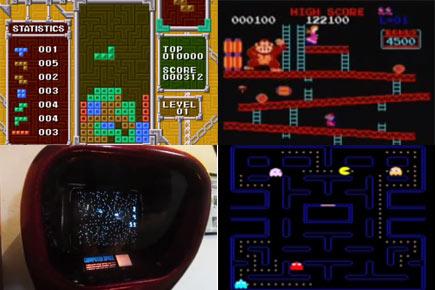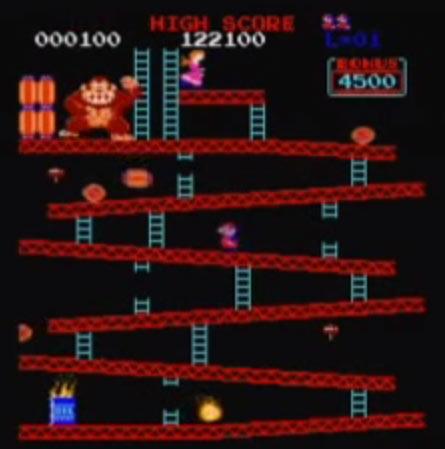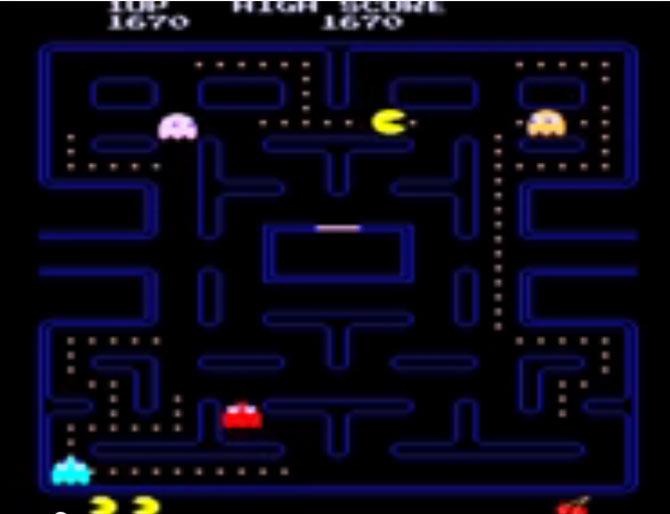On the 32nd anniversary of the release of classic arcade game Tetris, we turn back the clock and re-visit a list of widely known and played retro video games that continue to enjoy popularity among gamers in various forms of mass media even today...

Tetris: The tile-matching puzzle video game was released on June 6, 1984. Created by Russian video game designer Alexey Pajitnov in collaboration with Dmitry Pavlovsky and Vadim Gerasimov Tetris derived its name from the Greek numerical prefix tetra and tennis, Pajitnov's favourite sport. Alexey Pajitnov basedthe gameplay of Tetris around the concept of tetrominoes for the computer system Electronika 60.
ADVERTISEMENT

All pics/YouTube
The game is played with 7 geometric shapes that will fall down on the playing field in random order, which the player has to position before they fall in place. The gameplay is mostly unending.
Tetris exploded into mainstream popularity over the years and is available for nearly every video game console and computer operating system, as well as on portable devices such as smartphone and handheld video game systems. It is also the first entertainment software to be exported from the USSR to the US and published by Spectrum HoloByte for Commodore 64 and IBM PC. Many scientific researchers say that playing Tetris for prolonged periods of time can also lead to more efficient brain activity during play. The game has gone on to spawn numerous sequels and variations over the years since it's release. Welltris, Hatris, Tetris & Dr. Mario are some notable examples.
Donkey Kong: The 1981 Japanese video game conceived by Shigeru Miyamoto, introduced the world to the iconic Mario. The inaugural game, which went on to spawn a huge media franchise featured a single-screen platform/action puzzle type gameplay. The player controlled Mario (initially named Jumpman) and climb what appeared to be an under-construction building to rescue a lady (named Pauline), held hostage by the titular Donkey Kong, a large ape who happens to be the primary antagonist. Mario must evade barrels hurled at him by Donkey Kong at each level and make his way up. Extra points can also be collected along the way by picking up Pauline's lost items such as an umbrella, hat and purse. When you reach the top to rescue the lady, Donkey Kong grabs her and takes her to the next level.

Japanese video game giant Nintendo, the makers of Donkey Kong entered into a lawsuit with Universal Studios, who alleged that the video game was a trademark infringement of King Kong. The US District Court ruled in favour of Nintendo, which established the company as a major player in the industry and arguably gave the company the confidence that it could compete with the giants of American media.
Donkey Kong has won 7 world records in the Guinness World Records: Gamer's Edition 2008, which include: "First Use of Visual Storytelling in a Video Game" for the rudimentary cut scenes featured in the original Donkey Kong arcade game, and "Most Collectible Items in a Platform Game" for Donkey Kong 64.
Pong: American video game company Atari released the table-tennis sports game on the arcade platform on November 29 in 1972. It's makers Nolan Bushnell and Ted Dabney, the co-founders of Atari were also the creators of the 1971 game Computer Space, the world's first commercially sold coin-operated video game — and indeed, the first commercially sold video game of any kind.

Bushnell based the idea for Pong after viewing an electronic ping-pong game included in the Magnavox Odyssey, the world's first commercial home video game console created by rival company Magnavox. Pong is generally considered to be the first commercially successful arcade video game machine, which helped to establish the video game industry. (Read more)
Pac-man: Created by Japanese video game designer Toru Iwatani, Pac-man was developed and released by Namco on May 22, 1980. It was later licenced for distribution to American video game company Midway and released in the US in October 1980. Pac-Man is one of the longest running video game franchises from the golden age of video arcade games and is part of the collection of the Smithsonian Institution in Washington, D.C.[20] and of New York's Museum of Modern Art.

The gameplay comprises of multiple levels through which the main character, the titual Pacman makes his way via a series of maze like structures comprising of pac-dots, which he eats. Eating all the pac-dots enables the player to advance to the next level. Pac-man must avoid four ghost-like creatures when touched would cause the player to lose a life. Losing all the lives leads to the end of the game. Special power dots can enable Pac-man to eat the enemies although under a time-limit. Pac-man and following spin-offs made the game into a pop-culture phenomenon, spawning merchandise and among other things an animated TV series and a hit song named, 'Pac-Man Fever'.
Guinness World Records has awarded the Pac-Man series eight records in Guinness World Records: Gamer's Edition 2008, including First Perfect Pac-Man Game for Billy Mitchell's July 3, 1999 score and "Most Successful Coin-Operated Game". The game's creator Toru Iwatani officially received the certificate from Guinness World Records for Pac-Man having had the most "coin-operated arcade machines" installed world wide: 293,822 on June 3, 2010.
Asteroids: The game was designed by Atari employees Lyle Rains and Ed Logg. It was released in November 1979 and is considered to be one of the first major hits of the arcade video game platform during the golden era. The main object in Asteroids is to control a spaceship in an asteroid field which is periodically traversed by flying saucers and shoot and destroy asteroids and saucers while not colliding with either, or being hit by the saucers' counter-fire. The game becomes harder as the number of asteroids increases.

15-year-old American teenager Scott Safran of Cherry Hill, New Jersey, set a world record of 41,336,440 points on November 13, 1982, beating the 40,101,910 point score set by Leo Daniels of Carolina Beach on February 6, 1982. Asteroids among other classic video games will be depicted in the upcoming Hollywood film, 'Pixels'. An independent film adaptation by Universal Studios is said to be in the works since 2009.
Ported to mutliple platforms since its release and rise to popularity, Asteroids was widely imitated and directly influenced two popular and often cloned arcade games, Defender and Gravitar, as well as many other video games.
Space Invaders: The 1978 arcade classic is one of the earliest shooting games. The aim is to defeat waves of aliens with a laser cannon to earn as many points as possible. Developed by Japanese video game designer Tomohiro Nishikado, the game was one of the forerunners of modern video gaming and helped expand the video game industry from a novelty to a global industry. The 1980 Atari 2600 version quadrupled the system's sales and became the first "killer app" for video game consoles. Space Invaders has been the inspiration for other video games, re-released on numerous platforms, and led to several sequels.

One of its most noteworthy features is the use of continuous music—the well-known four-note loop—throughout, uninterrupted by sound effects. Many publications and websites use the pixelated alien graphic as an icon for video games in general. Space invaders has been depicted in various forms of media including television, film, books, music and much more.
There is a bridge in Cáceres, Spain, projected by engineers Pedro Plasencia and Hadrián Arias whose pavement design is based on this game. A French street artist called Invader made a name for himself by creating mosaic artwork of Space Invader aliens around the world.
Centipede: The vertically oriented shoot 'em up arcade game released in 1981 involved the player shooting a giant centepede with laser shots along with other creatures like spiders, scorpions and fleas in varios rounds over the course of the game.
Centipede was the creation of Atari employees Ed Logg and Dona Bailey. Co-creator Bailey, who was one of the few female game programmers in the industry wanted to create a video game that attracted women players. She and Logg succeeded in their goal; Centipede was one of the first arcade coin-operated games to have a significant female player base after Pac-Man.

Centepede was followed in 1982 by a sequel game titled Millipede. A newer version of the game was introduced in 1998 for the PC, Playstation and Dreamcast platform. It included free movement around the map, 3D graphics, and a campaign which can be played in both single and multi-player modes. The latest release in the frachise is Centipede: Infestation (2011).
A board game version of the game was released in 1983, which pits two players against each other in a race to be the first person to the opponent's home base with a centipede. Each player can utilize a blaster, as well as a scorpion and spider, to slow the opposing centipede's advance.
Computer Space: Generally accepted as, 'the world's first commercially sold coin-operated video game', Computer Space was released in November 1971. The brainchild of Atari co-founders Nolan Bushnell and Ted Dabney, the game is played by controlling a rocket ship, which should evade enemy fire from a pair of flying saucers moving in tandem. The player must fire back to destory the saucers by firing missiles. If his/her score is higher than that of the saucers at the end of 90 seconds, the player will get another 90 seconds of play, and the colors of the screen would switch to "Hyperspace", a game mode that makes the screen look like a photo negative. If at the end of this 90 seconds the player's score is still higher than that of the saucers, another 90 seconds would be awarded and the colors will revert to normal. This sequence is repeated indefinitely. Score is kept as a single digit ranging from zero to nine; for scores ten to fifteen, odd-looking characters would be displayed; once a score of fifteen is reached, the next hit will return the score to 0.

Computer Space was not a great success due to its complicated gameplay but was cloned by a game company named For-Play in 1972 and re-released as 'Star Trek' despite not bearing any resemblance to the hit sci-fi TV show of the same name. The game has been shown in the Hollywood films, 'Soylent Green' (1973) and 'Jaws' (1975).
Breakout: Created by Apple co-founders Steve Jobs and Steve Wozniak, based on a concept by Nolan Bushnell and Steve Bristow, the game was released in April 1976. Certain aspects of the Apple II personal computer have been inspired from Breakout.
The game is played by controlling a ball which travels across the screen, bouncing off the top and side walls of the screen with the aid of a movable paddle. The object is to use the ball to hit a layer of bricks lines the top third of the screen. The bricks are destoryed when hit by the ball and the player loses the game if it touches the bottom of the screen.

The success of Breakout led to the release of numerous sequels and cross-platform versions, most notably Super Breakout, Breakout 2000 and many others that were released on the IBM, PC, Playstation and even on mobile devices over the years. Similar games like Arkanoid, Hardball and many others have been played since then.
Google released a secret version of Breakout to commemorate the 37th anniversary of the game. Users had to type "Atari Breakout" on the Images search section to access it. The search makes the images turn different colors and a little ball and paddle are seen at the bottom. This is still accessible as of the release date.
 Subscribe today by clicking the link and stay updated with the latest news!" Click here!
Subscribe today by clicking the link and stay updated with the latest news!" Click here!







